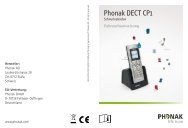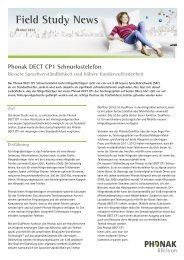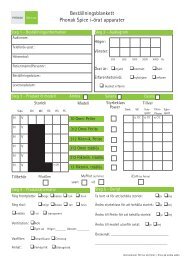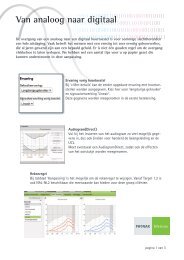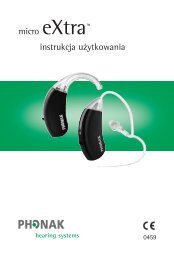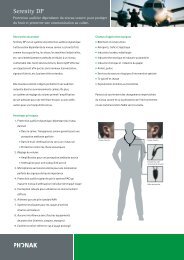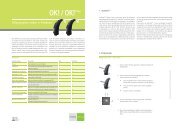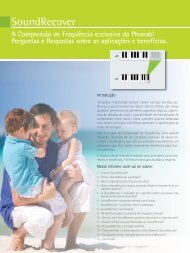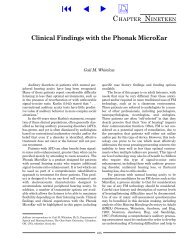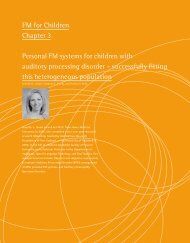directional microphone technology - Phonak
directional microphone technology - Phonak
directional microphone technology - Phonak
You also want an ePaper? Increase the reach of your titles
YUMPU automatically turns print PDFs into web optimized ePapers that Google loves.
Peter Stelmacovich<br />
FM Classroom and February SF 2013 Product Manager
2<br />
• What are the options for improving Signal to Noise Ratio<br />
• Noise Reduction Algorithms?<br />
• Directional Microphone Technology<br />
• Remote Mic + ComPilot<br />
• Fixed gain FM (Digital and FM)<br />
• Adaptive Gain FM<br />
• Pros and Cons of each approach<br />
• Selecting Ideal Candidates<br />
FM Classroom February 2013
SNR in typical Listening situations<br />
• One-on-One<br />
• Television<br />
• Small groups<br />
• Place of Worship<br />
• Car<br />
• Concert/movie<br />
• Restaurant<br />
• Large group<br />
+10 dB<br />
+5 dB<br />
+3 dB<br />
0 dB<br />
0 dB<br />
+3 dB<br />
-5 dB<br />
-10 dB<br />
FM Classroom February 2013
FM Classroom February 2013
FM Classroom February 2013
1) Directional hearing instruments<br />
2) Active noise reduction in hearing instruments<br />
3) Multiple programs<br />
4) Wireless transmission of the desired acoustic signal<br />
to the hearing instrument<br />
Almost always: binaural use of any technique shows better<br />
results than monaural use<br />
FM Classroom February 2013
Pediatric_A_GB<br />
without dNC<br />
with dNC medium<br />
Time<br />
• Optimized algorithm for channel<br />
dependent noise detection and<br />
supression<br />
• 3 levels to control the degree of<br />
reduction - light, moderate or strong to<br />
addresses individual needs<br />
• Improves comfort and “ease of<br />
listening” in noisy surroundings<br />
• Helps concentration - crucial for<br />
learning<br />
FM Classroom February 2013
• No documented empirical evidence<br />
demonstrating improved speech<br />
understanding in noise from hearing aid<br />
circuitry alone (Killion, 1997; Bentler, 2004;<br />
Ricketts 2004))<br />
• Useful for Comfort but does not improve<br />
signal to noise ratio. Works well when used<br />
in combination with <strong>directional</strong> <strong>microphone</strong>s<br />
(Plyler, 2007; Mueller et al 2006)<br />
FM Classroom February 2013
• Improvements in SNR for <strong>directional</strong> <strong>microphone</strong> <strong>technology</strong> over<br />
omni <strong>directional</strong> <strong>microphone</strong>s has been well documented.<br />
• Kochkin (Market Trak) use of <strong>directional</strong> <strong>microphone</strong> <strong>technology</strong> leads<br />
to increased performance and greater end user satisfaction.<br />
• Improved speech understanding (Valente et al, 1995; Gravel et al, 1999;<br />
Kuk et al, 1999; Preves et al, 1999; Pumford et al 2000; Rickets et al, 2000,<br />
2005; Cord, M, Surr, R, Walden, B, Olson, L., 2002; Bentler et al, 2006)<br />
• Documented range of improvement: 3-8 dB (Hawkins &Yacullo, 1984;<br />
Valente et al 1995; Gravel et al, 1999; Ricketts & Dhar, 1999; Pumford et al,<br />
2000, Valente et al, 2000).<br />
FM Classroom February 2013
• Sound waves coming from in front<br />
are enhanced<br />
• Sound waves coming from the side<br />
or behind are reduced<br />
• Improved speech understanding in<br />
noise regardless of the direction of<br />
noise<br />
• Studies show substantial benefit for<br />
adults in noisy environments<br />
(Condie et al 2002, Gravel, Hanin<br />
et al 2004.)<br />
FM Classroom February 2013
FM Classroom February 2013
Directional Microphones<br />
FM Classroom February 2013
13<br />
-35°<br />
0°<br />
35°<br />
- 60°<br />
60°<br />
-90°<br />
wider beam<br />
narrower beam<br />
90°<br />
-120°<br />
120°<br />
-150°<br />
180°<br />
150°<br />
FM Classroom February 2013
14<br />
Less wind noise<br />
Wind noise detection<br />
Wind noise detection<br />
Streaming<br />
The signal is filtered and<br />
mixed by the receiving<br />
hearing instrument<br />
FM Classroom February 2013
• Directional <strong>microphone</strong>s have proven benefits (3-5 dB improvement in SNR)<br />
• BUT, <strong>microphone</strong> location is still at the ear level<br />
• Higher SNR‟s can be obtained by moving the <strong>microphone</strong> closer to the signal<br />
of interest
FM Classroom February 2013
• By moving a <strong>microphone</strong> from<br />
the ear level to a much closer<br />
proximity to the talker‟s<br />
mouth, we can achieve higher<br />
signal-to-noise ratios<br />
• <strong>Phonak</strong>‟s solution involves the<br />
use of the Remote<br />
Microphone in conjunction<br />
with either a ComPilot or an<br />
iCom (backwards<br />
compatibility)
1. Improved SNR compared to ear level Directional Microphones<br />
2. Ease of Use. Simple and intuitive<br />
3. Convenient. ComPilot + Remote Mic gives client many solutions with just<br />
2 devices<br />
4. Cost. Very affordable solution, much less than FM
19<br />
• Wireless, omni<strong>directional</strong> <strong>microphone</strong><br />
• Voice transmission directly to the HIs via ComPilot<br />
• Streaming up to 20 meters (60 ft)<br />
• Up to 8h streaming time<br />
• No audible delay<br />
• Lightweight<br />
FM Classroom February 2013
• One-on-One conversations in noisy places<br />
• Listening to a speaker who is more than 2 meters away<br />
• Listening to a speaker who often changes position<br />
• When you cannot face the speaker (ie. in a car)<br />
FM Classroom February 2013
• Wear it at the correct location<br />
– Clipped to a shirt<br />
• Max 20 meters (66 ft) is the official number<br />
• 20 cm from speaker‟s mouth in noise<br />
– Can be placed on a table in quiet situations<br />
FM Classroom February 2013
Feature <strong>Phonak</strong> Dynamic FM Bluetooth Microphones<br />
Range 15m indoors. Up to 50 meters outdoors 15m (best case). Comfortable range is 8m<br />
SNR Up to 24 dB 12 dB<br />
Mic Selection Omni, Zoom, SuperZoom Omni only<br />
Connectivity<br />
Multiple receivers (ear level as well as<br />
inductive neck loop). Compatible with all<br />
brands of HI and CI. Audio input of all<br />
transmitters . Bluetooth on SmartLink+<br />
Sends only to one receiver (body-worn<br />
streamer)<br />
Operating Time 10-12 hours<br />
5 hours<br />
Applications Single speaker, report style, conference Single speaker only
• To achieve an improvement in SNR up from a Bluetooth Microphone system<br />
would be to use a fixed gain wireless system<br />
• Examples include:<br />
– <strong>Phonak</strong>‟s 2 nd Generation systems such as Campus, SmartLink SX,<br />
ZoomLink, EasyLink (silver casing)<br />
– Oticon Amigo<br />
– Comfort Audio Digisystem<br />
• These are all examples of fixed gain systems and achieve similar results<br />
• Most incorporate <strong>directional</strong> <strong>microphone</strong>s on the transmitters and therefore<br />
can achieve higher SNR‟s than Bluetooth <strong>microphone</strong>s<br />
• Additional benefits include greater operating ranges and longer battery life<br />
• However, cost is significantly higher
• 48 adults, 2 sites<br />
• Presbycusis<br />
• Transmitter 3 inches from<br />
loudspeaker<br />
• Correlated HINT noise<br />
from 4 other loudspeakers<br />
• SuperZoom setting on<br />
HandyMic, Claro HI‟s.<br />
•<br />
Source: Valente 2002<br />
FM Classroom February 2013
• Dynamic FM is different than fixed gain systems in that<br />
it adjusts the FM gain depending on the environmental<br />
noise level<br />
• Additional gain is added if the background noise level<br />
increases<br />
• Ambient noise levels are measured by the FM<br />
transmitter during speech pauses<br />
• If the ambient noise level rises to over 57 dB SPL, a<br />
command is sent from the transmitter to the Dynamic<br />
FM receivers to increase the FM Advantage<br />
• Examples: inspiro, SmartLink+, ZoomLink+,<br />
EasyLink+ and any 3 rd generation <strong>Phonak</strong> receiver (eg<br />
MLxi, ML9i to ML16i)
• The blue bar symbolizes the HI signal level<br />
• The FM level is usually louder<br />
• The difference is the SNR<br />
• Dynamic FM increases the FM level in noisy situations<br />
• Compression will reduce both the HI and the FM signal<br />
• The increased SNR is not affected by the compression in the<br />
hearing instrument<br />
SNR<br />
FM<br />
HI<br />
HI output<br />
signal levels<br />
FM Classroom February 2013
• Ambient noise levels are estimated by the FM transmitter during speech<br />
pauses<br />
• If the ambient noise level rises to over 57 dB SPL, a command is sent from<br />
the transmitter to the Dynamic FM receivers to increase the FM Advantage<br />
• This command is a digital code, sent with the FM signal at a different<br />
inaudible audio frequency<br />
• If the noise level drops again, the FM Advantage is smoothed (reduced)<br />
appropriately.<br />
FM Classroom February 2013
Dynamic FM gives 50%<br />
better word recognition than<br />
traditional FM in 73 dB(A)<br />
ambient noise!<br />
Reference: Benefits of Adaptive FM Systems on Speech Recognition in Noise for Listeners Who Use<br />
Hearing Aids. Linda Thibodeau. American Journal 36 of Audiology • Vol. 19 • 36–45 • June 2010<br />
FM Classroom February 2013
FM Classroom February 2013
• Candidacy:<br />
– Audiogram approach<br />
– LiSN-S/LiSN-S PGA<br />
– COSI<br />
• Factors to consider:<br />
– Dexterity<br />
– Technologically „Savy‟?<br />
– Ease of use<br />
– Listening situations<br />
– Cost<br />
FM Classroom February 2013
1. Children with hearing loss that attend special (deaf) schools<br />
2. Children with hearing loss that attend regular schools<br />
3. Adult hearing instrument users<br />
4. Children and adults with cochlear implants<br />
5. Children and adults with unilateral hearing loss<br />
6. Children and adults with auditory processing disorder<br />
7. Non native learners (ESL)<br />
8. Adults with multiple sclerosis<br />
9. Children with Autism spectrum disorder<br />
FM Classroom February 2013
• LiSN-S means Listening in Spatialized Noise – Sentences Under<br />
headphones a virtual 3D space is created with target sentences coming from<br />
the front and distracting sentences are coming from the left and the right.<br />
• It is like having a free field test under headphones with real life like conditions<br />
• The patient‟s task is to repeat sentences.<br />
• The distracting sentences are spoken by different voices than the target<br />
sentences, the condition is also called „Different voices ± 90º‟.<br />
• The professional enters the number of correct words.<br />
• LiSN-S is an adaptive test, the presentation level of the target sentences is<br />
adjusted automatically based on how many words were correct in the last<br />
sentence<br />
• The test ends automatically within 5 minutes.<br />
• LiSN-S has some unique features which will help fitters to justify their<br />
recommendations and which will convince patients of their hearing status and<br />
the required intervention<br />
FM Classroom February 2013
• LiSN-S PGA is a brand new diagnostic test that measures speech<br />
understanding in noise in patients with a hearing loss.<br />
• PGA means Prescribed Gain Amplifier the stimuli are amplified according<br />
to the pure tone audiogram according to the NAL RP rule.<br />
• If there is a conductive component in the hearing loss, bone conduction<br />
thresholds are taken into account.<br />
• LiSN-S accurately measures a patients ability to understand speech in noise<br />
as if they were wearing hearing instruments (amplification), and by comparing<br />
a patient‟s performance on LiSN-S PGA with normative data stored in the<br />
software, LiSN-S PGA predicts accurately the patient‟s performance in noisy<br />
situations compared to normal hearing listeners of the same age, and if the<br />
predicted performance is not good, LiSN-S PGA gives clear, individual,<br />
<strong>technology</strong> recommendations how to improve speech understanding in noise.<br />
• So based on the responses by the patient to the sentences, the patient gets<br />
an evidence based recommendation.<br />
FM Classroom February 2013
• Who should be tested with LiSN-S PGA?<br />
LiSN-S PGA has norms for age 6 to 60. Patients above 60 years old will be<br />
compared to the norms for 60 years old. The test is available in Australian<br />
English for Australia, New Zealand and UK and North American English for<br />
USA and Canada.<br />
FM Classroom February 2013
Run the test<br />
Professional clicks „start‟ button<br />
competing sentences are played back.<br />
Professional clicks „next‟ button.<br />
Patient hears a beep and then<br />
the target sentence.<br />
Patient repeats the sentence.<br />
Professional enters the number of correctly<br />
repeated words<br />
FM Classroom February 2013
• LiSN-S PGA is an adaptive test, which ends automatically.<br />
FM Classroom February 2013
LiSN-S PGA‟s results mention clearly loss in signal-to-noise ratio (dB)<br />
The value (Loss in SNR) has been<br />
calculated by comparison with normative<br />
data for the average person of the same<br />
age with normal hearing.<br />
A cross (x) is displayed in the bar<br />
diagram indicating the individual<br />
score of the patient.<br />
Next to the x the <strong>technology</strong><br />
recommendations are listed, in clear<br />
wordings for both the professional<br />
and the patient<br />
FM Classroom February 2013
X<br />
With amplification the patient‟s loss of speech understanding in<br />
noise is very mild, and the patient should be able to understand<br />
speech almost as well as people with normal hearing.<br />
FM Classroom February 2013
X<br />
Even with amplification, the patient will require speech to have a SNR<br />
significantly better than people with normal hearing in order to understand<br />
the speech. In many situations (where there is a close target talker or a<br />
close dominant noise source) advanced <strong>directional</strong> <strong>microphone</strong><br />
<strong>technology</strong> will enable the patient to understand speech in noise almost<br />
as well as people with normal hearing.<br />
FM Classroom February 2013
X<br />
Even with amplification, the patient will require speech to have a SNR<br />
significantly better than people with normal hearing in order to understand<br />
the speech. Bluetooth RemoteMic <strong>technology</strong> or fixed gain FM will<br />
enable the patient to understand speech in noise almost as well as people<br />
with normal hearing.<br />
Lower Yellow or Upper Red<br />
FM Classroom February 2013
X<br />
FM Classroom February 2013<br />
Even with hearing aids incorporating advanced <strong>directional</strong> <strong>microphone</strong><br />
<strong>technology</strong> the patient will require speech to have a SNR significantly better<br />
than people with normal hearing in order to understand the speech. In<br />
adverse listening conditions the patient is likely to be able to understand<br />
speech only with the aid of Dynamic FM <strong>technology</strong> coupled to the<br />
patient‟s hearing aids.
Peter Stelmacovich<br />
FM Classroom and February SF 2013 Product Manager



